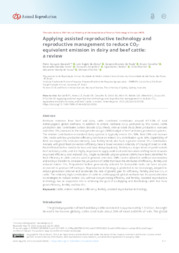Applying assisted reproductive technology and reproductive management to reduce CO2-equivalent emission in dairy and beef cattle: a review.
Applying assisted reproductive technology and reproductive management to reduce CO2-equivalent emission in dairy and beef cattle: a review.
Author(s): BARUSELLI, P. S.; ABREU, L. A. de; PAULA, V. R. de; CARVALHO, B. C. de; GRICIO, E. A.; MORI, F. K.; REBEIS, L. M.; ALBERTINI, S.; SOUZA, A. H. de; D'OCCHIO
Summary: Methane emission from beef and dairy cattle combined contributes around 4.5-5.0% of total anthropogenic global methane. In addition to enteric methane (CH4) produced by the rumen, cattle production also contributes carbon dioxide (CO2) (feed), nitrous oxide (N2O) (feed production, manure) and other CH4 (manure) to the total greenhouse gas (GHG) budget of beef and dairy production systems. The relative contribution in standard dairy systems is typically enteric CH4 58%, feed 29% and manure 10%. Herds with low production efficiency can have an enteric CH4 contribution up to 90%. Digestibility of feed can impact CH4 emission intensity. Low fertility herds also have a greater enteric CH4 contribution. Animals with good feed conversion efficiency have a lower emission intensity of CH4/kg of meat or milk. Feed efficient heifers tend to be lean and have delayed puberty. Fertility is a major driver of profit in both beef and dairy cattle, and it is highly important to apply multi-trait selection when shifting herds towards improved efficiency and reduced CH4. Single nucleotide polymorphisms (SNPs) have been identified for feed efficiency in cattle and are used in genomic selection. SNPs can be utilized in artificial insemination and embryo transfer to increase the proportion of cattle that have the attributes of efficiency, fertility and reduced enteric CH4. Prepubertal heifers genomically selected for favourable traits can have oocytes recovered to produce IVF embryos. Reproductive technology is predicted to be increasingly adopted to reduce generation interval and accelerate the rate of genetic gain for efficiency, fertility and low CH4 in cattle. The relatively high contribution of cattle to anthropogenic global methane has focussed attention on strategies to reduce enteric CH4 without compromising efficiency and fertility. Assisted reproductive technology has an important role in achieving the goal of multiplying and distributing cattle that have good efficiency, fertility and low CH4.
Publication year: 2023
Types of publication: Journal article
Unit: Embrapa Dairy Cattle
Observation
Some of Embrapa's publications are published as ePub files. To read them, use or download one of the following free software options to your computer or mobile device. Android: Google Play Books; IOS: iBooks; Windows and Linux: Calibre.
Access other publications
Access the Agricultural Research Database (BDPA) to consult Embrapa's full library collection and records.
Visit Embrapa Bookstore to purchase books and other publications sold by Embrapa.

